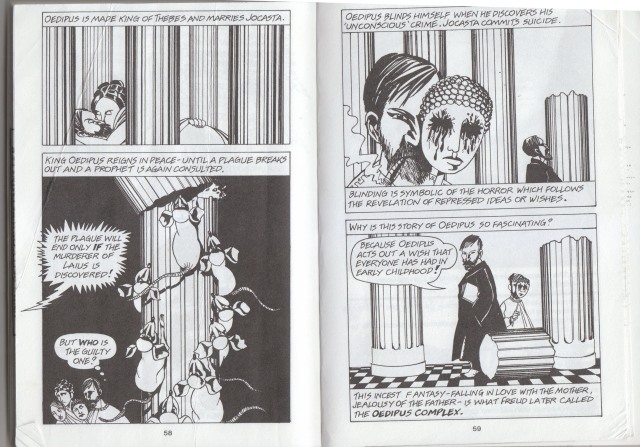A picture, they say, is worth a thousand words.
As such, we often begin our lessons with an image. When I am starting to study a thinker, I usually look for one of the books in the "Introducing" series, or else for a diagram which sums up their ideas. Usually many of these are available on line. "RSA Animate" works this trick. We believe that once we have seen and made real a concept, we will better be able to grasp it, that it will provide a "map" for the oncoming conceptual territory. Are we right?
 |
| R. Appignanesi & O. Zarate, (2007), ‘Introducing Freud: A Graphic Guide to the Father of Pyschoanalysis,‘ Icon Books |
Another teacher records a lesson for A-Level English students in which they were asked to depict literary characters on a paper plate – drawing a face on the plate - and then asked to use stickers to define the character’s principal traits - pinning the stickers on their clothes and mingling with other students, while they introduce themselves ‘in character’.
BUT! To me it was important that my class thought they knew Miller before they discovered who he really was, and so I was quite happy to show them a picture of the man. And don't textbooks have pictures? Is that so wrong?
 |
| Good show |
Having worked on this assumption before, with (as I took it) some success, it was naturally enough the method I took when I began to study Hegel. It was here that I encountered a crushing brick wall. There are no pictorial representations of Hegel's system of thought. I hope here to make it clearer why this was, by reference to Hegel's idea of Vorstellen and Derry's (2013) case for a kind of philosophical method called social epistemology.
1. - Epistemology - Hegel sends no postcards
 |
| He never remembers Mothers' Day either |
Any enquiry into the way we see the world shouldn't start with what we see. Instead it should start with what we think we see. This is the justification for studying epistemology, sometimes called "theory of knowledge".
Hegel was a philosopher whose work has been taken as a starting point for epistemological enquiry. Students who encounter Hegel here are struck by his notorious difficulty, a topic he even writes of somewhat boastfully in his Phenomenology of Spirit.
The study of epistemology is not, at least in the first instance, the study of perceptions, but rather of the thought of perceptions. Hegel calls this the Notion or the Concept. Given that thoughts may be pictured better in words than in any other form, any study of representations can begin with the study of a manifesto of the ideology which leads us to mistake lines on a page for an idea. We do not study the marks on the page but rather the type of mind which thinks those marks meaningful. I think both sides in the above argument could make use of that assertion, so let us leave it there for now.
 |
| Get on with it |
The upsetting thing for most of us is that although we have a visual sense and can achieve things with it, including mimesis - the staggering feat of fooling another consciousness into believing they are looking at what we believe we have seen. It is problematic, then, that we have no real idea how it works. When it comes to the mind we are all like a one of Arthur C Clarke's space tribes in the Foundation novels.
In these books, Clarke paints a picture of a future which has collapsed and where Science is soley preserved on one planet. The others are doomed instead to spend their time working the few remaining pieces of "Old Empire" technology. They do this with centuries old rituals, their original purpose long since forgotten. So we too are working the levers of rituals which keep us in touch with Reality without understanding how they work. We might know that what we are doing produces results, in terms of creating our worldview, but whoever dreamt it up is long gone. As was well said, "The half understood sayings of Aristotle became the laws of thought".
My confusion with Hegel came from the fact that I thought I should be able to see a picture of what he was talking about. To me it made sense that a thinker's work should be open to pictorial abstraction, in order to take a Heuristic starting point.
However, any satisfactory representation of the Dialectic should also include the opposite of itself. It is not, therefore logically possible to draw a picture of Hegel's system without subsequently erasing the entire picture. A picture offers us a statement, "This is that". The negation of such a statement, "This is not that" it is not possible to represent. We cannot paint a "not yellow" picture (Vitale), despite this being part of the truth.
The conclusion, that This is both That and Other (Subject and Object) cannot be shown and yet, for Hegel, this is all. Thus in the "fluid system" (PoS - 327) which is Spirit (in which, for Hegel, Truth is entirely one), there is no abstraction for simplicity's sake but rather a continuing "sequence of movements" or steps. To picture to ourselves the very endlessness of this, as a continual process of revision and doubt, can be seen as a important moment in itself. Continual 'fluid' revision, as in Heraclitus' "Other and other rivers run", applies here.
For precisely this reason, one cannot head speculatively into Hegel's writing, with a mind to moving there later. Like a country which does not issue visitors' Visas, Hegel's thought demands we leave our old nations behind if we want to see what happens there; this is not to imply that we may not sit in antechambers and have conversations on the border, even for our entire lifetime if necessary. However, we do not get to Holiday in Spirit. We must inhabit it, or else be baffled by it. One could say the same about Teaching - and indeed Hegel was a teacher for his entire adult life, first as a tutor and then in schools and universities.
Hegel has a word for the type of mistake which leads us to think that a picture is enough to satisfy. He calls it Vorstellen, translated by A.V. Miller (no relation to Arthur) in his translation as "picture language". Derry (2013) following Brandom renders this as "representation". In opposition to this Hegel places the Rational or the Actual. The Actual, Phenomenal world is always represented as a system, because only a system can contain the various moves and countermoves which are relevant to reality.
The constantly shifting theatre of forms, then, is closest to being what Truth is, a constant process of revision and improvement. This worldview is communicated, says Hegel, to render us "ready to do Science".
3.
For a teacher, this could well seem a long way from offering the kind of straightforward program which is teachable in a rainy INSET day. How this relates to the classroom, however, is critical.
If a teacher chooses to relate a concept to Dizzy Rascal, it can of course overtake and dominate the entire lesson. One would hate to walk away thinking one had taught them about Verbs when actually the students think they just sat around and talked about Grime getting a "live" but not a "life" lesson. On top of this, there's nothing sadder than a cool teacher - its like Dads dancing at weddings. Many teachers with understandable concerns about this could find themselves swayed by demagogic talk of "the collapse of standards". Recently, the Secretary of State for Education has made this point repeatedly and persuasively.
However, if Hegel is correct and Vorstellen is not interactive with the type of thing that mind is, then calls for Evidence of any teacher's effectiveness which repeat claims for "Data" will not hold water. "Data" is nothing but another form of representation, it is still not good enough for our purposes, and never can be. Assessment, for example, cannot show what it appears to show. Rather, it must be used as part of an Inferential process which is related to spending time in an environment (and certainly not the requisite OFSTED 20 minutes) in which connections between knowers exist. If we do not stay somewhere with another knower long enough to form a connection, then we have not discovered anything. The challenge of Social Epistemology is levelled at everyone, from the minor damage to knowledge done by teachers who indulge the students a little too long in the picture starter to the potentially far more serious damage done by an educational establishment in thrall to graphs.
 |
| This is a picture of a graph. It is therefore a picture of a picture. |
The seductive thing about representations of Rationality, such as the "representationalist paradigm (of awareness understood in representational terms) inaugurated by Descartes and influential in Anglo-Saxon thought ever since" (Derry 2013) is that it appears not to suffer from the flaws of Vorstellen. By these lights and in their terms, this prevents the emergence of the epistemic state of knowing.
"For number is just that completely quiescent, lifeless and indifferent determinateness in which all movement and relation is extinguished, and which has broken the bridge to the living element of instincts, manner of life, and other aspects of sensuous existence."
- Hegel, PoS - 286
4. Conclusions
The objective here is not victory, it is not a zero sum game. What we are doing is in strict conflict with all systems that present simple competition as being universally relevant to the sort of thing Phenomena are. It's like basing your theory of mind on X Factor. These simple, spontaneous systems, especially those parts of them which are knowable, are necessarily known through a process of connection and inference between parties, and moves from one position to the other will always present us with unexpected pictures which explode or efface those preceeding.
However, I would also not wish to repeat the old joke and say that the path for improvement does not "start from here". This is why I say that if you read this on a Sunday night with a Powerpoint slide bursting with "Relevant" images ready to go, don't change a thing. On the other hand, it does indicate that thinking you have connected when there is a moment of recognition in the students' eyes is something of a fool's paradise.
Meanwhile, if you are still on the "other side", and still believe that such things as sides exist, then ask yourself whether the mask of numbers is really that different to a paper plate with a literary character's name on it and eyeholes punched through. Are you on Foundation, or are you a steam priest pulling Aristotelian levers, their meaning long forgotten? And how would you know?
What matters, however, is that all parties concerned have made an effort to connect the subject with the students, and to open up the space to one where Inferences of a conflicting nature about the the new concept can be made. Of course we cannot doubt first principles and pass a class, and discussions of those kinds are rightly kept for detentions, parent meetings and home tuition at vast cost. However, if we are not willing to discover what the first principles of others are before we rely on our own, more systematic pictures of Phenomena to explode or be exploded by them, we will educate nobody.
 |
| She has inferred incorrectly - that does not make her anti-knowledge |
References
Derry, J. (2013) Can Inferentialism Contribute to Social Epistemology? in Journal of Philosophy of Education Volume 47, Issue 2, May 2013
No comments:
Post a Comment